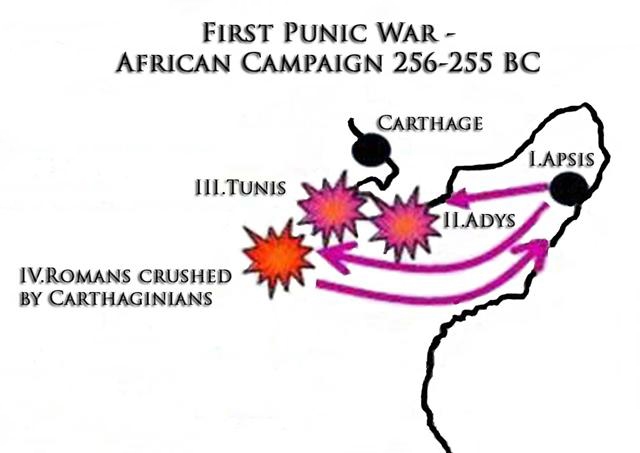First Punic War—264-241 BC
Phase 3: African Campaign, 256-255 BC
The African Campaign
After their victory at Ecnomus, the Roman fleet with its two legions sailed for Africa, Simultaneously, they sent to Rome for instructions. The Romans landed on the Eastern or seaward side of Cape Bon. The Carthaginians, not feeling strong enough to oppose the invasion force, locked themselves in their city while the Romans began raiding the countryside. The Romans captured 20,000 slaves and a significant amount of booty which they shipped back to Rome along with a large number of cattle.
This map image was downloaded from Wikipedia http://en.wikipedia.org/wiki/File:Africainvasion.JPG on 11.01.09 and modified in Photoshop by Jules Korzeniowski 11.12.09. Permission is granted to copy, distribute and/or modify this document under the terms of the GNU Free Documentation License, Version 1.2 or any later version published by the Free Software Foundation; with no Invariant Sections, no Front-Cover Texts, and no Back-Cover Texts. A copy of the license is included in the section entitled “GNU Free Documentation License”.
| First Punic War — Events of the African Campaign — 256-255 BC |
|---|
|
The Roman fleet is challenged by the Carthaginian fleet off Cape Bon and the Roman fleet wins a decisive victory; subsequently the Carthaginians offer no naval challenge to the Romans
Return to Sicily
The crushing Roman defeat in Africa was followed, on the way back to Sicily, by a naval disaster, when the admirals, ignoring the advice of their experienced pilots, ran into a storm off the rugged southern coast of Sicily that left 80 seaworthy ships of an original 364. The loss of life must have staggered the coastal Greek cities of southern Italy and the Italian cities of Latium and Campania.
Polybius. The Rise of the Roman Empire. Ian Scott-Kilvert (Trans.), 1979. Penguin Books, Ltd. London.

